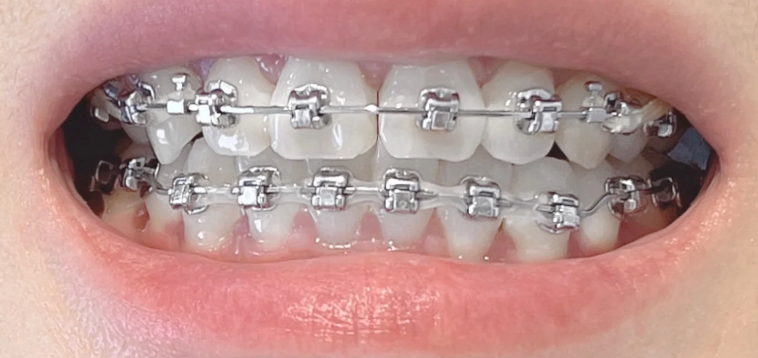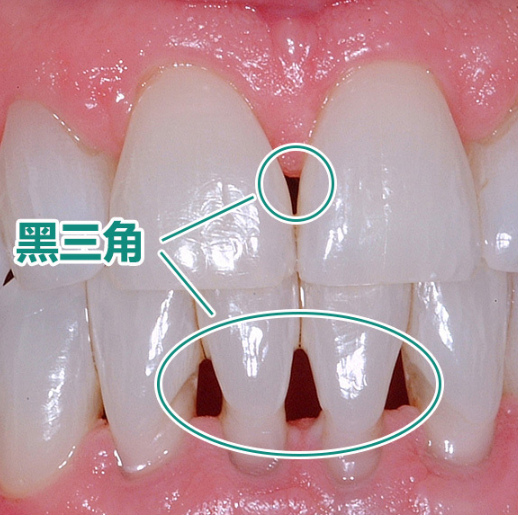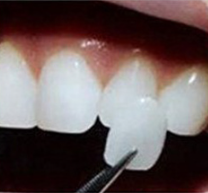 2023.06.29
2023.06.29
I heard that orthodontics can cause a black triangle![]()
Who said that? Braces don't take the blame!
It's not really all about orthodontics ......
Orthodontics may cause a black triangle, but it doesn't necessarily cause a black triangle if you have orthodontics!

What is a black triangle?
A "black triangle" is a "black hole" between two teeth that are close together
![]() Misconceptions:
Misconceptions:
Many people who have orthodontic treatment regret the "black triangle" that appears when their teeth are aligned. People then assume that the "black triangle" is caused by orthodontics.
![]() Truth:
Truth:
In fact, most "black triangles" in the teeth are caused by gum recession. When teeth are not cleaned and scaled for a long time, the gums eventually recede and do not completely cover the neck of the teeth, leaving the roots exposed, commonly known as the "black triangle".

Why is there a black triangle:
1. Physiological gum recession
Commonly seen in the elderly, as we age the gums will recede a little and the incidence of the black triangle will increase, but it will only cause minor tooth sensitivity.
2. Periodontitis
If you do not pay attention to personal oral hygiene for a long time, it leads to the accumulation of calculus and plaque at the gum margin and between the teeth. Inflammation occurs under the close contact between plaque and periodontal tissues, which subsequently causes red and swollen gums, bad breath, loose teeth, and the gums will slowly recede, exposing the roots of the teeth.
3. Misalignment of teeth
Crowded teeth can lead to soft tartar and tartar between the teeth not being easily cleaned and chronic inflammation of the gums, which can lead to receding gums. When, through orthodontics, the otherwise crowded teeth are aligned, the excessive gaps between adjacent teeth are exposed, resulting in a visible black triangle of gums.
4. Problems with the shape of the teeth themselves
The "black triangle" is often found in the anterior region (rarely in the posterior region), mainly because the teeth in the anterior region are relatively narrow and long, mostly triangular in shape and the point of contact between the two teeth is relatively high, making it easy to create a black triangle.
How to deal with the Black Triangle?
Now that you know the causes of the dark triangle, take care of it in your daily life. It will not bother you very much. But what should I do if a black triangle has already formed on my teeth?
01. Treatment
a. Slicing, you can grind off a little of the adjacent surfaces of the teeth and close the gap in conjunction with orthodontics. This way the contact point between the two teeth will be higher and the black triangle can be improved.

b. Dental veneers, this is one of the better solutions to the black triangle.
Specifically, a complete dental veneer is applied to the surface of your teeth to improve the black triangle by appropriately increasing the profile of your teeth.

02. Prevention
Although there are many ways to treat the black triangle, it is more important to keep it from happening than to fix or cover it up afterwards.
It's the same old adage: prevention is always better than cure.
✅Regular oral check-ups and 1-2 dental cleanings per year to get rid of calculus
✅Correction of poor oral cleaning habits, with the use of interdental cleaning tools
✅Quit unhealthy eating habits, stop smoking and drinking less carbonated drinks
✅Choose a trusted provider and an experienced orthodontist for your orthodontic treatment
✅Gum massage can be done daily during orthodontic treatment
![]() Remember! The appearance of the black triangle is an irreversible process and the main focus is on prevention, paying attention to oral hygiene and prior periodontal maintenance to prevent the appearance of the black triangle, rather than waiting until it actually appears before treating it.
Remember! The appearance of the black triangle is an irreversible process and the main focus is on prevention, paying attention to oral hygiene and prior periodontal maintenance to prevent the appearance of the black triangle, rather than waiting until it actually appears before treating it.









